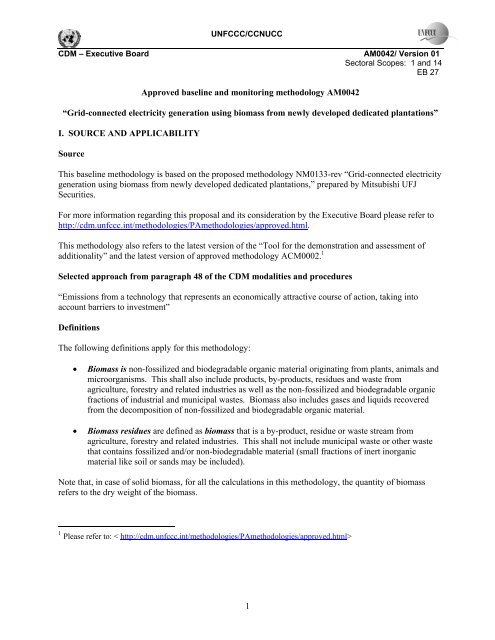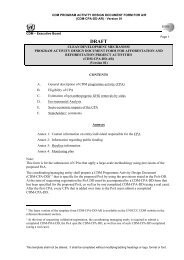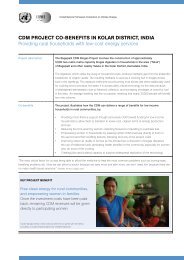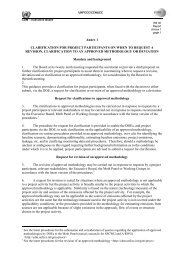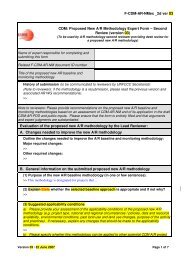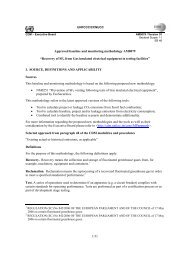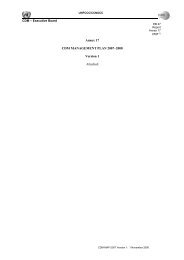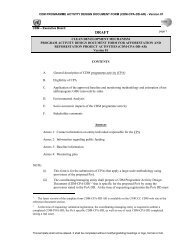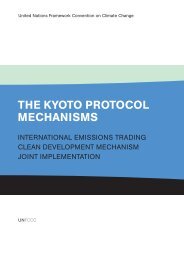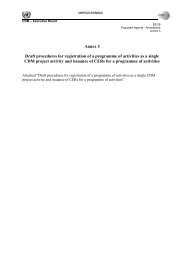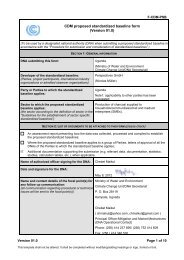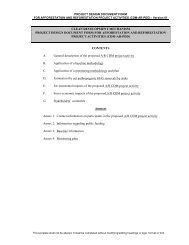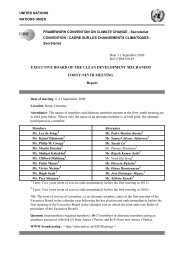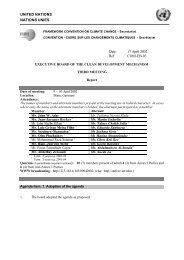1 Approved baseline and monitoring methodology AM0042 ... - CDM
1 Approved baseline and monitoring methodology AM0042 ... - CDM
1 Approved baseline and monitoring methodology AM0042 ... - CDM
Create successful ePaper yourself
Turn your PDF publications into a flip-book with our unique Google optimized e-Paper software.
UNFCCC/CCNUCC<br />
<strong>CDM</strong> – Executive Board <strong>AM0042</strong>/ Version 01<br />
Sectoral Scopes: 1 <strong>and</strong> 14<br />
EB 27<br />
<strong>Approved</strong> <strong>baseline</strong> <strong>and</strong> <strong>monitoring</strong> <strong>methodology</strong> <strong>AM0042</strong><br />
“Grid-connected electricity generation using biomass from newly developed dedicated plantations”<br />
I. SOURCE AND APPLICABILITY<br />
Source<br />
This <strong>baseline</strong> <strong>methodology</strong> is based on the proposed <strong>methodology</strong> NM0133-rev “Grid-connected electricity<br />
generation using biomass from newly developed dedicated plantations,” prepared by Mitsubishi UFJ<br />
Securities.<br />
For more information regarding this proposal <strong>and</strong> its consideration by the Executive Board please refer to<br />
http://cdm.unfccc.int/methodologies/PAmethodologies/approved.html.<br />
This <strong>methodology</strong> also refers to the latest version of the “Tool for the demonstration <strong>and</strong> assessment of<br />
additionality” <strong>and</strong> the latest version of approved <strong>methodology</strong> ACM0002. 1<br />
Selected approach from paragraph 48 of the <strong>CDM</strong> modalities <strong>and</strong> procedures<br />
“Emissions from a technology that represents an economically attractive course of action, taking into<br />
account barriers to investment”<br />
Definitions<br />
The following definitions apply for this <strong>methodology</strong>:<br />
• Biomass is non-fossilized <strong>and</strong> biodegradable organic material originating from plants, animals <strong>and</strong><br />
microorganisms. This shall also include products, by-products, residues <strong>and</strong> waste from<br />
agriculture, forestry <strong>and</strong> related industries as well as the non-fossilized <strong>and</strong> biodegradable organic<br />
fractions of industrial <strong>and</strong> municipal wastes. Biomass also includes gases <strong>and</strong> liquids recovered<br />
from the decomposition of non-fossilized <strong>and</strong> biodegradable organic material.<br />
• Biomass residues are defined as biomass that is a by-product, residue or waste stream from<br />
agriculture, forestry <strong>and</strong> related industries. This shall not include municipal waste or other waste<br />
that contains fossilized <strong>and</strong>/or non-biodegradable material (small fractions of inert inorganic<br />
material like soil or s<strong>and</strong>s may be included).<br />
Note that, in case of solid biomass, for all the calculations in this <strong>methodology</strong>, the quantity of biomass<br />
refers to the dry weight of the biomass.<br />
1 Please refer to: < http://cdm.unfccc.int/methodologies/PAmethodologies/approved.html><br />
1
UNFCCC/CCNUCC<br />
<strong>CDM</strong> – Executive Board <strong>AM0042</strong>/ Version 01<br />
Sectoral Scopes: 1 <strong>and</strong> 14<br />
EB 27<br />
Applicability<br />
The <strong>methodology</strong> is applicable under the following conditions:<br />
• The project activity involves the installation of a new grid-connected power plant that is mainly fired<br />
with renewable biomass from a dedicated plantation (fossil fuels or other types of biomass may be cofired);<br />
• Prior to the implementation of the project activity, no power was generated at the project site (i.e. the<br />
project plant does not substitute or amend any existing power generation at the project site);<br />
• The geographic <strong>and</strong> system boundaries for the relevant electricity grid can be clearly identified <strong>and</strong><br />
information on the characteristics of the grid is available;<br />
• Biomass used by the project facility is not stored for more than one year;<br />
• The dedicated plantation must be newly established as part of the project activity for the purpose of<br />
supplying biomass exclusively to the project.<br />
• The biomass from the plantation is not chemically processed (e.g. esterification to produce biodiesel,<br />
production of alcohols from biomass, etc) prior to combustion in the project plant but it may be<br />
processed mechanically or be dried;<br />
• The site preparation does not cause longer-term net emissions from soil carbon. Carbon stocks in soil<br />
organic matter, litter <strong>and</strong> deadwood can be expected to decrease more due to soil erosion <strong>and</strong> human<br />
intervention or increase less in the absence of the project activity;<br />
• The l<strong>and</strong> area of the dedicated plantation will be planted by direct planting <strong>and</strong>/or seeding;<br />
• After harvest, regeneration will occur either by direct planting or natural sprouting;<br />
• Grazing will not occur within the plantation;<br />
• No irrigation is undertaken for the biomass plantations;<br />
• The l<strong>and</strong> area where the dedicated plantation will be established is, prior to project implementation,<br />
severely degraded <strong>and</strong> in absence of the project activity would have not been used for any other<br />
agricultural or forestry activity. The l<strong>and</strong> degradation can be demonstrated using one or more of the<br />
following indicators:<br />
(a) Vegetation degradation, e.g.,<br />
- crown cover of pre-existing trees has decreased in the recent past for reasons other than<br />
sustainable harvesting activities;<br />
(b) Soil degradation, e.g.,<br />
- soil erosion has increased in the recent past;<br />
- soil organic matter content has decreased in the recent past.<br />
(c) Anthropogenic influences, e.g.,<br />
- there is a recent history of loss of soil <strong>and</strong> vegetation due to anthropogenic actions; <strong>and</strong><br />
- demonstration that there exist anthropogenic actions/activities that prevent possible<br />
occurrence of natural regeneration.<br />
2
UNFCCC/CCNUCC<br />
<strong>CDM</strong> – Executive Board <strong>AM0042</strong>/ Version 01<br />
Sectoral Scopes: 1 <strong>and</strong> 14<br />
EB 27<br />
Furthermore, this <strong>methodology</strong> is only applicable if the most plausible <strong>baseline</strong> scenarios are:<br />
• For power generation, electricity generated by the project would have been generated by existing<br />
<strong>and</strong>/or new power plants in the grid; <strong>and</strong><br />
• For the use of biomass residues, If biomass residues are co-fired in the project plant case B1, B2,<br />
B3, B4 <strong>and</strong>/or B5. If case B5 is the most plausible scenario, the <strong>methodology</strong> is only applicable if:<br />
(a) The plant where the biomass residues would be used as feedstock in the absence of the project<br />
activity can be clearly identified throughout the crediting periods; <strong>and</strong><br />
(b) The fuels used as substitutes for the biomass residues at the plant, referred in (a) above, can be<br />
monitored by project participants.<br />
II. BASELINE METHODOLOGY<br />
Project boundary<br />
The physical delineation of the project boundary is the physical extent of the project site, where electricity<br />
generating activity occurs <strong>and</strong> the geographic boundaries of the dedicated plantation. In addition, the<br />
project boundary is extended to include emissions from the biomass transportation to the power generation<br />
site. The project boundary also includes the power plants connected physically to the electricity system<br />
that the <strong>CDM</strong> project power plant is connected to. Please refer to ACM0002 for further details of the<br />
project boundary with respect to the electricity grid.<br />
Project emissions include:<br />
• CO 2 emissions from co-firing fuels in the project plant other than biomass from the dedicated<br />
plantation or biomass residues;<br />
• CO 2 emissions from combustion of fossil fuels at the site of the project plant, other than fossil fuels<br />
co-fired in the project plant, that are attributable to the project activity;<br />
• CO 2 emissions from the consumption of electricity at the site of the project plant that is attributable<br />
to the project activity (e.g. for mechanical processing of the biomass);<br />
• CO 2 emissions from off-site transportation of biomass used to fuel the project plant;<br />
• CH 4 emissions from combustion of biomass in the power plant.<br />
If the complete l<strong>and</strong> area of the dedicated plantation is included in the project boundary of one or several<br />
registered <strong>CDM</strong> A/R project activities, no further emission sources need to be included in the project<br />
boundary. 2 Otherwise, the following project emission sources related to the production of the biomass shall<br />
also be considered:<br />
• CO 2 emissions from fossil fuel consumption during agricultural operations;<br />
• GHG emissions from the production of fertilizer that is used at the plantation;<br />
• N 2 O emissions from the application of fertilizer at the plantation;<br />
• CH 4 <strong>and</strong> N 2 O emissions from the field burning of biomass.<br />
2 The Board, at its 25 th meeting, agreed that the emissions associated with A/R activity should be accounted for in the<br />
A/R <strong>CDM</strong> project activity. In general all project activities using biomass for energy should account for emissions<br />
associated with production of biomass. However, in the case that it can be demonstrated that for a project activity<br />
using biomass for energy, which uses biomass originating from a registered A/R project activity (i.e. through<br />
contractual agreement for procurement of biomass) it need not account for emissions related to biomass production.<br />
3
UNFCCC/CCNUCC<br />
<strong>CDM</strong> – Executive Board <strong>AM0042</strong>/ Version 01<br />
Sectoral Scopes: 1 <strong>and</strong> 14<br />
EB 27<br />
For the purpose of determining the <strong>baseline</strong> emissions, project participants shall include the following<br />
emission sources:<br />
• CO 2 emissions from electricity generation in fossil fuel fired power plants that are displaced due to<br />
the project activity.<br />
4
UNFCCC/CCNUCC<br />
<strong>CDM</strong> – Executive Board <strong>AM0042</strong>/ Version 01<br />
Sectoral Scopes: 1 <strong>and</strong> 14<br />
EB 27<br />
Table 1: Summary of gases <strong>and</strong> sources included in the project boundary, <strong>and</strong> justification /<br />
explanation where gases <strong>and</strong> sources are not included.<br />
Source Gas Included? Justification / Explanation<br />
Baseli<br />
ne<br />
Project Activity<br />
Grid electricity<br />
generation<br />
On-site fuel<br />
consumption<br />
Combustion of<br />
biomass for<br />
electricity (<strong>and</strong><br />
heat) generation<br />
Off-site fossil<br />
fuel combustion<br />
for transportation<br />
of biomass to the<br />
project plant<br />
Electricity<br />
consumption at<br />
the project site<br />
Fuel<br />
consumption in<br />
agriculture<br />
operations<br />
Fertilizer<br />
production<br />
Fertilizer<br />
application<br />
Field burning of<br />
biomass<br />
CO 2<br />
CH 4<br />
N 2 O<br />
CO 2<br />
CH 4<br />
N 2 O<br />
CO 2<br />
CH 4<br />
N 2 O<br />
CO 2<br />
CH 4<br />
N 2 O<br />
CO 2<br />
CH 4<br />
N 2 O<br />
Yes<br />
No<br />
No<br />
Yes<br />
No<br />
No<br />
No<br />
Yes<br />
No<br />
Yes<br />
No<br />
No<br />
Yes<br />
No<br />
No<br />
CO 2 Yes 3<br />
CH 4<br />
N 2 O<br />
No<br />
No<br />
CO 2 Yes 3<br />
CH 4 Yes 3<br />
N 2 O Yes 3<br />
N 2 O<br />
Yes 3<br />
CO 2<br />
No<br />
CH 4 Yes 3<br />
N 2 O Yes 3<br />
Excluded for simplification. This is conservative.<br />
Excluded for simplification. This emission source<br />
is assumed to be small.<br />
Excluded for simplification. This emission source<br />
is assumed to be small.<br />
It is assumed that CO 2 emissions from surplus<br />
biomass do not lead to changes in carbon pools.<br />
Excluded for simplification. This emission source<br />
is assumed to be small.<br />
Excluded for simplification. This emission source<br />
is assumed to be small.<br />
Excluded for simplification. This emission source<br />
is assumed to be small.<br />
Excluded for simplification. This emission source<br />
is assumed to be small.<br />
Excluded for simplification. This emission source<br />
is assumed to be small.<br />
Excluded for simplification. This emission source<br />
is assumed to be small. 6<br />
Excluded for simplification. This emission source<br />
is assumed to be small. 6<br />
CO 2 emissions from biomass burning are assumed<br />
not lead to changes in carbon pools<br />
3 This emission source does not need to be included in the project boundary, if the complete l<strong>and</strong> area of the<br />
dedicated plantation is included in the project boundary of one or several registered <strong>CDM</strong> A/R project activities.<br />
5
UNFCCC/CCNUCC<br />
<strong>CDM</strong> – Executive Board <strong>AM0042</strong>/ Version 01<br />
Sectoral Scopes: 1 <strong>and</strong> 14<br />
EB 27<br />
Procedure for the selection of the most plausible <strong>baseline</strong> scenario<br />
The <strong>baseline</strong> scenario is determined through the following steps:<br />
1. Identification of realistic <strong>and</strong> credible alternative scenarios that are consistent with applicable laws <strong>and</strong><br />
regulations;<br />
2. Identify barriers <strong>and</strong> assess which alternative scenarios are not prevented by these barriers;<br />
3. If there is still more than one alternative scenario remaining, project participants may either identify the<br />
alternative scenario with the lowest emissions (i.e. the most conservative) as the <strong>baseline</strong> scenario or<br />
may conduct an investment analysis.<br />
Step 1. Identification of alternative scenarios to the proposed <strong>CDM</strong> project activity that are<br />
consistent with current laws <strong>and</strong> regulations<br />
Project participants are to identify all realistic <strong>and</strong> credible alternatives to the project activity that are<br />
consistent with current laws <strong>and</strong> regulations. Alternatives include, but are not limited to, the following<br />
scenarios:<br />
• The project carried out without the <strong>CDM</strong>;<br />
• Other comparable projects that are fuelled by renewable sources;<br />
• Other comparable projects that are fuelled by fossil fuels;<br />
• The generation of power in existing <strong>and</strong> / or new grid-connected power plants.<br />
The alternatives to the project activity shall be in compliance with all applicable legal <strong>and</strong> regulatory<br />
requirements - taking into account EB decisions with respect to national <strong>and</strong>/or sectoral policies <strong>and</strong><br />
regulations in determining a <strong>baseline</strong> scenario 4 - even if these laws <strong>and</strong> regulations have objectives other<br />
than GHG reductions, e.g. to mitigate local air pollution.<br />
If an alternative does not comply with all applicable legislation <strong>and</strong> regulations, then show that, based on an<br />
examination of current practice in the country or region in which the law or regulation applies, those<br />
applicable legal or regulatory requirements are systematically not enforced <strong>and</strong> that non-compliance with<br />
those requirements is widespread in the country. If this cannot be shown, then eliminate the alternative<br />
from further consideration.<br />
4 Annex 3 of the 22nd EB meeting report: “Clarifications on the treatment of national <strong>and</strong>/or sectoral policies <strong>and</strong><br />
regulations (paragraph 45(e)) of the <strong>CDM</strong> Modalities <strong>and</strong> Procedures) in determining a <strong>baseline</strong> scenario (version<br />
2)”<br />
6
UNFCCC/CCNUCC<br />
<strong>CDM</strong> – Executive Board <strong>AM0042</strong>/ Version 01<br />
Sectoral Scopes: 1 <strong>and</strong> 14<br />
EB 27<br />
If the project will co-fire biomass residues, realistic <strong>and</strong> credible alternatives should be separately<br />
determined for what would happen to the biomass residues in the absence of the project activity. The<br />
alternatives (including combinations) to be analyzed for use of biomass residues may include, inter alia:<br />
7
UNFCCC/CCNUCC<br />
<strong>CDM</strong> – Executive Board <strong>AM0042</strong>/ Version 01<br />
Sectoral Scopes: 1 <strong>and</strong> 14<br />
EB 27<br />
B1<br />
B2<br />
B3<br />
B4<br />
B5<br />
B6<br />
B7<br />
B8<br />
The biomass residues are dumped or left to decay under mainly aerobic conditions. This applies,<br />
for example, to dumping <strong>and</strong> decay of biomass residues on fields.<br />
The biomass residues are dumped or left to decay under clearly anaerobic conditions. This<br />
applies, for example, to deep l<strong>and</strong>fills with more than 5 meters. This does not apply to biomass<br />
residues that are stock-piled 5 or left to decay on fields.<br />
The biomass residues are burnt in an uncontrolled manner without utilizing them for energy<br />
purposes.<br />
The biomass residues are sold to other consumers in the market <strong>and</strong> the predominant use of the<br />
biomass residues in the region/country is for energy purposes (heat <strong>and</strong>/or power generation)<br />
The biomass residues are used as feedstock in a process (e.g. in the pulp <strong>and</strong> paper industry)<br />
The biomass residues are used as fertilizer<br />
The proposed project activity not undertaken as a <strong>CDM</strong> project activity (use of the biomass<br />
residues in the project plant)<br />
Any other use of the biomass residues<br />
Where different types or sources of biomass residues are used in the project activity, the most plausible<br />
<strong>baseline</strong> scenario for the use of biomass residues should be determined for each type <strong>and</strong> source of biomass<br />
separately. The respective biomass residue types, quantities <strong>and</strong> sources should be documented<br />
transparently in the draft <strong>CDM</strong>-PDD.<br />
Step 2. Barrier analysis to eliminate alternatives to the project activity that face prohibitive barriers<br />
Establish a complete list of barriers that would prevent alternative scenarios to occur in the absence of the<br />
<strong>CDM</strong>, using the guidance in Step 3 of the latest version of the “Tool for the demonstration <strong>and</strong> assessment<br />
of additionality”.<br />
Since the proposed project activity not being registered as a <strong>CDM</strong> project activity shall be one of the<br />
considered alternatives, any barrier that may prevent the project activity to occur shall be included in that<br />
list. Show which alternatives are prevented by at least one of the barriers previously identified <strong>and</strong><br />
eliminate those alternatives from further consideration. All alternatives shall be compared to the same set<br />
of barriers.<br />
If there is only one scenario alternative that is not prevented by any barrier, then this scenario alternative is<br />
identified as the <strong>baseline</strong> scenario.<br />
Where more than one credible <strong>and</strong> plausible alternative remains, project participants shall, as a<br />
conservative assumption, use the alternative <strong>baseline</strong> scenario that results in the lowest <strong>baseline</strong> emissions<br />
as the most likely <strong>baseline</strong> scenario, or conduct an investment analysis (Step 3).<br />
Step 3. Investments analysis (optional)<br />
Conduct an investment analysis, consistent with the guidance in Step 2 of the latest version of the “Tool for<br />
the demonstration <strong>and</strong> assessment of additionality”. The economically most attractive alternative is<br />
deemed as the most plausible <strong>baseline</strong> scenario.<br />
5 Further work is undertaken to investigate to which extent <strong>and</strong> in which cases methane emissions may occur from<br />
stock-piling biomass residues. Subject to further insights on this issue, the <strong>methodology</strong> may be revised.<br />
8
UNFCCC/CCNUCC<br />
<strong>CDM</strong> – Executive Board <strong>AM0042</strong>/ Version 01<br />
Sectoral Scopes: 1 <strong>and</strong> 14<br />
EB 27<br />
The above steps should be conducted taking into account relevant national <strong>and</strong>/or sectoral policies <strong>and</strong><br />
circumstances. In doing so, the latest <strong>CDM</strong> EB guidance on the treatment of national <strong>and</strong>/or sectoral<br />
policies <strong>and</strong> regulations in determining a <strong>baseline</strong> scenario shall be adhered to.<br />
Additionality<br />
This <strong>methodology</strong> uses the latest version of the “Tool for demonstration <strong>and</strong> assessment of additionality”<br />
that is available on the UNFCCC web site.<br />
Baseline emissions<br />
Baseline emissions are CO 2 emissions from the displacement of electricity generation in grid-connected<br />
fossil fuel fired power plants. Baseline emissions are calculated as follows:<br />
BE<br />
y<br />
EGPJ<br />
, y<br />
⋅ EFgrid<br />
, y<br />
= (1)<br />
Where:<br />
BE y<br />
EG PJ,y<br />
EF grid,y<br />
= Baseline emissions in year y (tCO 2 /yr)<br />
= Net quantity of electricity generated in the project plant in the year y (MWh/yr)<br />
= Grid emission factor in year y, monitored <strong>and</strong> calculated according to the latest approved<br />
version of ACM0002 (tCO 2 /MWh)<br />
Project Emissions<br />
Total project emissions are given as follows:<br />
PE<br />
y<br />
PEFC, on site,<br />
y<br />
+ PEEC,<br />
y<br />
+ PETP,<br />
y<br />
+ PEBF<br />
, y<br />
+ PEFC,<br />
PL,<br />
y<br />
+ PEFP,<br />
y<br />
+ PEFA,<br />
y<br />
+ PEBB,<br />
y<br />
=<br />
−<br />
(2)<br />
Where:<br />
PE y<br />
PE FC,on-site,y<br />
PE EC,y<br />
PE TP,y<br />
PE BF,y<br />
PE FC,PL,y<br />
PE FP,y<br />
PE FA,y<br />
PE BB,y<br />
= Project emissions in year y (tCO 2 /yr)<br />
= Project emissions in year y from co-firing fossil fuels in the project plant <strong>and</strong>/or from other<br />
fossil fuel combustion that occurs at the site of the project plant <strong>and</strong> that is attributable to<br />
the project activity (tCO 2 /yr)<br />
= Project emissions from electricity consumption at the site of the project plant that is<br />
attributable to the project activity (e.g. for mechanical processing of the biomass) in year y<br />
(tCO 2 /yr)<br />
= Project emissions related to transportation of the biomass from the dedicated project<br />
plantation <strong>and</strong>/or biomass residues to the power plant in year y (tCO 2 /yr)<br />
= Project emissions from combustion of the renewable biomass from the dedicated project<br />
plantation <strong>and</strong> biomass residues in the project plant in year y (tCO 2 e/yr)<br />
= Project emissions related to fossil fuel consumption at the plantation during agricultural<br />
operations in year y (tCO 2 /yr)<br />
= Project emissions related to the production of synthetic fertilizer that is used at the<br />
dedicated plantation in year y (tCO 2 e/yr)<br />
= Project emissions related to the application of fertilizers at the plantation in year y<br />
(tCO 2 e/yr)<br />
= Project emissions arising from field burning of biomass at the plantation site (tCO 2 e/yr)<br />
9
UNFCCC/CCNUCC<br />
<strong>CDM</strong> – Executive Board <strong>AM0042</strong>/ Version 01<br />
Sectoral Scopes: 1 <strong>and</strong> 14<br />
EB 27<br />
a) CO 2 emissions from fuel combustion (PE FC,on-site,y )<br />
This emission source should include CO 2 emissions from all fuel consumption that occurs at the site of the<br />
project plant <strong>and</strong> that is attributable to the project activity. This includes:<br />
• fossil fuels co-fired in the project plant;<br />
• biomass co-fired in the project plant other than the biomass from the dedicated plantation or<br />
biomass residues;<br />
• fuel consumption for mechanical preparation or drying of the biomass.<br />
CO 2 emissions from firing biomass from the dedicated plantation <strong>and</strong>/or biomass residues should not be<br />
included. Emissions shall be calculated as follows:<br />
∑<br />
PE<br />
FC, on−site,<br />
y<br />
= FCon−site,<br />
i,<br />
y<br />
⋅ NCVi<br />
⋅ EFCO2,<br />
FF , i<br />
(3)<br />
i<br />
Where:<br />
PE FC,on-site,y<br />
FC on-site,i,y<br />
NCV i<br />
EF CO2,FF,i<br />
i<br />
= Project emissions in year y from co-firing fossil fuels in the project plant <strong>and</strong>/or from other<br />
fossil fuel combustion that occurs at the site of the project plant <strong>and</strong> that is attributable to<br />
the project activity (tCO 2 /yr)<br />
= Amount fuel type i that is (a) co-fired in the project plant <strong>and</strong>/or is (b) combusted at the site<br />
of the project plant <strong>and</strong> attributable to the project activity, during the year y (mass or<br />
volume unit) 6<br />
= Net calorific value of fuel type i (GJ / mass or volume unit)<br />
= CO 2 emission factor of fuel type i (tCO 2 /GJ)<br />
= Fossil fuels or biomass fuel types other than the biomass from the dedicated plantation or<br />
biomass residues<br />
b) CO 2 emissions from on-site electricity consumption (PE EC,y )<br />
CO 2 emissions from on-site electricity consumption (PE EC,y ) are calculated by multiplying the electricity<br />
consumption by an appropriate grid emission factor, as follows:<br />
PE<br />
EC, y<br />
ECPJ<br />
, y<br />
⋅ EFgrid<br />
, y<br />
= (4)<br />
Where:<br />
PE EC,y<br />
EC PJ,y<br />
EF grid,y<br />
= Project emissions from electricity consumption at the site of the project plant that is<br />
attributable to the project activity (e.g. for mechanical processing of the biomass) in year y<br />
(tCO 2 /yr)<br />
= On-site electricity consumption attributable to the project activity during the year y (MWh)<br />
= Grid emission factor in year y, monitored <strong>and</strong> calculated according to the latest approved<br />
version of ACM0002 (tCO 2 /MWh)<br />
6 Preferably use a mass unit for solid fuels <strong>and</strong> a volume unit for liquid <strong>and</strong> gaseous fuels.<br />
10
UNFCCC/CCNUCC<br />
<strong>CDM</strong> – Executive Board <strong>AM0042</strong>/ Version 01<br />
Sectoral Scopes: 1 <strong>and</strong> 14<br />
EB 27<br />
c) CO 2 emissions from fossil fuel combustion due to transportation of biomass from the plantation site(s)<br />
to the site of the project plant (PE TP,y )<br />
This emission source includes CO 2 emissions from the transportation of biomass from the dedicated<br />
plantation site(s) <strong>and</strong> biomass residues from their source of generation to the project plant. Emissions may<br />
be calculated either based on information on the number of trips, the return trip distance <strong>and</strong> CO 2 emission<br />
factors of the vehicles (Option 1) or based on data on the actual fuel consumption of vehicles (Option 2).<br />
Where the biomass is obtained from different sources with different distances <strong>and</strong>/or transported in<br />
different types of vehicles, emissions should be calculated separately for the different distances <strong>and</strong><br />
vehicles types.<br />
Option 1:<br />
Emissions are calculated on the basis of distance <strong>and</strong> the number of trips (or the average truck load):<br />
PE<br />
= N ⋅ AVD ⋅ EF<br />
(5)<br />
TP, y y y km,<br />
CO2<br />
or<br />
∑<br />
BF<br />
PJ , j,<br />
y<br />
j<br />
PE<br />
TP, y<br />
= ⋅ AVDy<br />
⋅ EFkm,<br />
CO2,<br />
y<br />
TLy<br />
(6)<br />
Where:<br />
PE TP,y<br />
N y<br />
AVD y<br />
EF km,CO2,y<br />
= Project emissions related to transportation of the biomass from the dedicated project<br />
plantation <strong>and</strong>/or biomass residues from their source of generation to the power plant in year<br />
y (tCO 2 /yr)<br />
= Number of truck trips during the year y<br />
= Average return trip distance (from <strong>and</strong> to) between the source of the biomass <strong>and</strong> the site of<br />
the project plant during the year y (km),<br />
Average CO 2 emission factor for the trucks measured during the year y (tCO 2 /km)<br />
BF PJ,j,y = Quantity of biomass type j fired in the project plant in the year y (tons of dry matter or liter) 7<br />
TL y = Average truck load of the trucks used (tons or liter)<br />
j = All types of renewable biomass from the dedicated project plantation <strong>and</strong> types of biomass<br />
residues that are fired in the project plant<br />
Option 2:<br />
Emissions are calculated based on the actual quantity of fossil fuels consumed for transportation.<br />
PE<br />
TP, y<br />
FCTR,<br />
i,<br />
y<br />
⋅ NCVi<br />
⋅ EFCO2,<br />
FF , i<br />
i<br />
= ∑ (7)<br />
7 Use tons of dry matter for solid biomass residues <strong>and</strong> liter for liquid biomass residues.<br />
11
UNFCCC/CCNUCC<br />
<strong>CDM</strong> – Executive Board <strong>AM0042</strong>/ Version 01<br />
Sectoral Scopes: 1 <strong>and</strong> 14<br />
EB 27<br />
Where:<br />
PE CO2,TR,y<br />
FC TR,i,y<br />
NCV i<br />
EF CO2,FF,i<br />
= CO 2 emissions from off-site transportation of biomass residues to the project site (tCO 2 /yr)<br />
= Fuel consumption of fuel type i used in trucks for transportation of biomass during the year<br />
y (mass or volume unit) 6<br />
= Net calorific value of fuel type i (GJ / mass or volume unit)<br />
= CO 2 emission factor for fossil fuel type i (tCO 2 /GJ)<br />
d) CH 4 emissions from combustion of biomass (PE BF,y )<br />
CH 4 emissions are associated with the combustion of biomass fired in the project plant. This is calculated<br />
as follows:<br />
∑( BFPJ<br />
, j,<br />
y<br />
⋅ NCV<br />
j<br />
⋅ EFCH<br />
4, BF j<br />
)<br />
PE<br />
,<br />
= GWP<br />
4<br />
⋅<br />
,<br />
(8)<br />
BF y<br />
CH<br />
j<br />
Where:<br />
PE BF,y = Project emissions from combustion of the renewable biomass from the dedicated project<br />
plantation <strong>and</strong> biomass residues in the project plant in year y (tCO 2 e/yr)<br />
GWP CH4 = Global Warming Potential of methane valid for the commitment period (tCO 2 e/tCH 4 )<br />
BF PJ,j,y = Quantity of biomass type j fired in the project plant in the year y (tons of dry matter or liter) 7<br />
NCV j = Net calorific value of biomass fuel type j (GJ/ton of dry matter or GJ/liter)<br />
EF CH4,BF,j = CH 4 emission factor for the combustion of biomass type j in the project plant (tCH 4 /GJ)<br />
j = All types of renewable biomass from the dedicated project plantation <strong>and</strong> types of biomass<br />
residues that are fired in the project plant<br />
To determine the CH 4 emission factor, project participants may conduct measurements at the plant site or<br />
use IPCC default values, as provided in Table 2 below. The uncertainty of the CH 4 emission factor in<br />
many cases is relatively high. In order to reflect this <strong>and</strong> for the purpose of providing conservative<br />
estimates of emission reductions, a conservativeness factor must be applied to the CH 4 emission factor.<br />
The level of the conservativeness factor depends on the uncertainty range of the CH 4 emission factor<br />
estimate . Appropriate conservativeness factors from Table 3 below shall be chosen <strong>and</strong> shall be multiplied<br />
with the estimated CH 4 emission factor.<br />
For example, where the default CH 4 emission factor of 30 kg/TJ from Table 2 below is used, for which the<br />
uncertainty is estimated to be 300%, <strong>and</strong> the conservativeness factor for the uncertainty is 1.37 (from Table<br />
3). Thus, in this case a CH 4 emission factor of (30*1.37= ) 41.1 kg/TJ should be used.<br />
Table 2. Default CH 4 emission factors for combustion of biomass residues 8<br />
Default<br />
emission factor<br />
(kg CH 4 / TJ)<br />
Assumed uncertainty<br />
Wood waste 30 300%<br />
Sulphite lyes (Black Liquor) 3 300%<br />
Other solid biomass residues 30 300%<br />
Liquid biomass residues 3 300%<br />
8 Values are based on the 2006 IPCC Guidelines, Volume 2, Chapter 2, Tables 2.2 to 2.6.<br />
12
UNFCCC/CCNUCC<br />
<strong>CDM</strong> – Executive Board <strong>AM0042</strong>/ Version 01<br />
Sectoral Scopes: 1 <strong>and</strong> 14<br />
EB 27<br />
Table 3. Conservativeness factors<br />
Estimated uncertainty range (%)<br />
Assigned<br />
uncertainty b<strong>and</strong><br />
(%)<br />
Conservativeness factor<br />
where higher values are<br />
more conservative<br />
Less than or equal to 10 7 1.02<br />
Greater than 10 <strong>and</strong> less than or equal to 30 20 1.06<br />
Greater than 30 <strong>and</strong> less than or equal to 50 40 1.12<br />
Greater than 50 <strong>and</strong> less than or equal to 100 75 1.21<br />
Greater than 100 150 1.37<br />
e) CO 2 emissions from fossil fuel consumption during agricultural operations (PE FC,PL,y )<br />
CO 2 emissions associated with fossil fuel consumption at the plantation are calculated as follows:<br />
∑<br />
PE = FC ⋅ NCV ⋅ EF<br />
(9)<br />
FC,PL,y<br />
PL,i,y i CO2<br />
,FF,i<br />
i<br />
Where:<br />
PE FC,PL,y<br />
FC PL,i,y<br />
NCV i<br />
EF CO2,FF,i<br />
i<br />
= Project emissions related to fossil fuel consumption at the plantation during agricultural<br />
operations in year y (tCO 2 /yr)<br />
= Amount of fuel type i that is combusted at the dedicated plantation during the year y (mass<br />
or volume unit) 6<br />
= Net calorific value of fuel type i (GJ / mass or volume unit)<br />
= CO 2 emission factor of fuel type i (tCO 2 /GJ)<br />
= Fuel types used for combustion at the dedicated plantation<br />
f) Emissions from the production of synthetic fertilizer that is used at the plantation (PE FP,y )<br />
The GHG emissions from the production of synthetic fertilizer are estimated for each synthetic fertilizer<br />
type f by multiplying an emission factor with the monitored quantity of fertilizer applied at the plantation<br />
during the year y, as follows:<br />
( EF F )<br />
PE<br />
,<br />
= ∑ 2 , ,<br />
⋅<br />
, ,<br />
(10)<br />
FP y<br />
f<br />
CO e FP f<br />
SF<br />
f<br />
y<br />
Where:<br />
PE FP,y<br />
EF CO2e,FP,f<br />
F SF,f,y<br />
f<br />
= Project emissions related to the production of synthetic fertilizer that is used at the<br />
dedicated plantation in year y (tCO 2 e/yr)<br />
= Emission factor for GHG emissions associated with the production of fertilizer type f<br />
(tCO 2 e/kg fertilizer)<br />
= Amount of synthetic fertilizer of type f applied in year y (kg fertilizer/yr)<br />
= Types of synthetic fertilizers applied at the dedicated plantation<br />
13
UNFCCC/CCNUCC<br />
<strong>CDM</strong> – Executive Board <strong>AM0042</strong>/ Version 01<br />
Sectoral Scopes: 1 <strong>and</strong> 14<br />
EB 27<br />
g) N 2 O emissions from application of fertilizers at the plantation (PE FA,y )<br />
N 2 O emissions are associated with the application of both organic <strong>and</strong> synthetic fertilizers, <strong>and</strong> are emitted<br />
through direct soil emissions <strong>and</strong> indirect emissions from atmospheric deposition <strong>and</strong> leaching <strong>and</strong> run-off.<br />
Emissions are calculated as follows.<br />
( PE PE )<br />
44<br />
= (11)<br />
2<br />
28<br />
PE<br />
FA y<br />
GWPN<br />
O<br />
⋅ ⋅<br />
N O − N , dir,<br />
y<br />
+<br />
N O − N , ind , y<br />
, 2<br />
2<br />
Where:<br />
PE FA,y<br />
GWP N2O<br />
PE N2O-N,dir,y<br />
PE N2O-N,ind,y<br />
= Project emissions related to the application of fertilizers at the dedicated plantation in<br />
year y (tCO 2 e/yr)<br />
= Global Warming Potential of nitrous oxide valid for the commitment period<br />
(tCO 2 e/tN 2 O)<br />
= Direct N 2 O-N emissions as a result of nitrogen application at the dedicated plantation<br />
during the year y (tN 2 O-N/yr)<br />
= Indirect N 2 O-N emissions as a result of nitrogen application at the dedicated plantation<br />
during the year y (tN 2 O-N/yr)<br />
Direct soil N 2 O emissions<br />
( F F )<br />
PE<br />
,<br />
N 2 O− N , dir,<br />
y<br />
= EFN<br />
2O−<br />
N , dir<br />
⋅<br />
ON , y<br />
+<br />
SN y<br />
(12)<br />
Where:<br />
PE N2O-N,dir,y = Direct N 2 O-N emissions as a result of nitrogen application at the dedicated plantation<br />
during the year y (tN 2 O-N/yr)<br />
EF N2O-N,dir = Emission factor for direct nitrous oxide emissions from N inputs (kg N 2 O-N/kg N)<br />
F ON,y<br />
= Amount of organic fertilizer nitrogen from animal manure, sewage, compost or other<br />
organic amendments applied at the dedicated plantation during the year y (t N/yr)<br />
F SN,y<br />
= Amount of synthetic fertilizer nitrogen applied at the dedicated plantation during the<br />
year y (t N/yr)<br />
Indirect N 2 O emissions<br />
Note: This source of emission is not to be accounted for in the case of a woody plantation.<br />
Indirect N 2 O emissions comprise N 2 O emissions due to atmospheric decomposition of N volatilized from<br />
the plantation <strong>and</strong> N 2 O emissions from leaching/run-off:<br />
PE<br />
N 2O<br />
− N , ind , y<br />
= PEN<br />
2O<br />
− N , ind , ATD,<br />
y<br />
+ PEN<br />
2O<br />
− N , ind , L,<br />
y<br />
(13)<br />
Where:<br />
PE N2O-N,ind,y<br />
PE N2O-N,ind,ATD,y<br />
PE N2O-N,ind,L,y<br />
= Indirect N 2 O-N emissions as a result of nitrogen application at the dedicated plantation<br />
during the year y (tN 2 O-N/yr)<br />
= Indirect N 2 O-N emissions due to atmospheric deposition of volatilized N, as a result of<br />
nitrogen application at the dedicated plantation during the year y (tN 2 O-N/yr)<br />
= Indirect N 2 O-N emissions due to leaching/run-off, as a result of nitrogen application at<br />
14
UNFCCC/CCNUCC<br />
<strong>CDM</strong> – Executive Board <strong>AM0042</strong>/ Version 01<br />
Sectoral Scopes: 1 <strong>and</strong> 14<br />
EB 27<br />
the dedicated plantation during the year y (tN 2 O-N/yr)<br />
Indirect N 2 O emissions due to atmospheric decomposition are calculated as follows:<br />
( FSN<br />
, y<br />
⋅ FracGASF<br />
+ FON<br />
, y<br />
⋅ FracGASM<br />
) ⋅ EFN<br />
2O<br />
N ATD<br />
PE<br />
N 2O−<br />
N , ind , ATD,<br />
y<br />
− ,<br />
= (14)<br />
Where:<br />
PE N2O-N,ind,ATD,y = Indirect N 2 O-N emissions due to atmospheric deposition of volatilized N, as a result of<br />
nitrogen application at the dedicated plantation during the year y (tN 2 O-N/yr)<br />
F SN,y<br />
= Amount of synthetic fertilizer nitrogen applied at the dedicated plantation during the<br />
year y (t N/yr)<br />
Frac GASF = Fraction of synthetic fertilizer N that volatilizes as NH 3 <strong>and</strong> NO X (kg N volatilized / kg<br />
N applied)<br />
F ON,y<br />
= Amount of organic fertilizer nitrogen from animal manure, sewage, compost or other<br />
organic amendments applied at the dedicated plantation during the year y (t N/yr)<br />
Frac GASM = Fraction of organic N fertilizer that volatilizes as NH 3 <strong>and</strong> NO X (kg N volatilized / kg<br />
N applied)<br />
EF N2O-N,ATD = Emission factor for atmospheric deposition of N on soils <strong>and</strong> water surfaces (t N 2 O-N /<br />
t N volatilized)<br />
Indirect N 2 O emissions due to leaching <strong>and</strong> runoff are calculated as follows:<br />
( FSN<br />
, y<br />
+ FON<br />
, y<br />
) ⋅ FracLEACH<br />
⋅ EFN<br />
2O<br />
N L<br />
PE<br />
N 2O−<br />
N , ind , L,<br />
y<br />
− ,<br />
= (15)<br />
Where:<br />
PE N2O-N,ind,L,y<br />
F SN,y<br />
F ON,y<br />
Frac LEACH<br />
EF N2O-N,L<br />
= Indirect N 2 O-N emissions due to leaching/run-off, as a result of nitrogen application at<br />
the dedicated plantation during the year y (tN 2 O-N/yr)<br />
= Amount of synthetic fertilizer nitrogen applied at the dedicated plantation during the<br />
year y (t N/yr)<br />
= Amount of organic fertilizer nitrogen from animal manure, sewage, compost or other<br />
organic amendments applied at the dedicated plantation during the year y (t N/yr)<br />
= Fraction of synthetic <strong>and</strong> organic fertilizer N that is lost through leaching <strong>and</strong> runoff<br />
(kg N leached <strong>and</strong> runoff / kg N applied)<br />
= Emission factor for N 2 O emissions from N leaching <strong>and</strong> runoff (t N 2 O-N / t N leached<br />
<strong>and</strong> runoff)<br />
h) CH 4 <strong>and</strong> N 2 O emissions from the field burning of biomass<br />
Biomass may be burnt at the start of the project activity (for l<strong>and</strong> clearance) or regularly during the<br />
crediting period (e.g. after harvest). In these cases, CH 4 <strong>and</strong> N 2 O emissions should be calculated for each<br />
time that field burning is occurring, as follows:<br />
PE<br />
BB, y<br />
B<br />
B<br />
f<br />
( EF ⋅ GWP + EF ⋅ GWP )<br />
= A ⋅ M ⋅ C ⋅<br />
(13)<br />
N2O,BB<br />
N2O<br />
CH4,BB<br />
CH4<br />
15
UNFCCC/CCNUCC<br />
<strong>CDM</strong> – Executive Board <strong>AM0042</strong>/ Version 01<br />
Sectoral Scopes: 1 <strong>and</strong> 14<br />
EB 27<br />
Where:<br />
= Project emissions arising from field burning of biomass at the plantation site (tCO 2 e/yr)<br />
= Area burned (ha)<br />
= Average mass of biomass available for burning on the area (t dry matter/ha)<br />
= Combustion factor, accounting for the proportion of fuel that is actually burnt<br />
(dimensionless)<br />
EF N2O,BB = N 2 O emission factor for field burning of biomass (tN 2 O/tonne of dry matter)<br />
GWP N2O = Global Warming Potential of nitrous oxide valid for the commitment period (tCO 2 e/tN 2 O)<br />
EF CH4,BB = CH 4 emission factor for field burning of biomass (tCH 4 /tonne of dry matter)<br />
GWP CH4 Global Warming Potential of methane valid for the commitment period (tCO 2 e/tCH 4 )<br />
PE BB,y<br />
A B<br />
M B<br />
C f<br />
Leakage<br />
An important potential source of leakage for this project activity is an increase in emissions from fossil fuel<br />
combustion or other sources due to diversion of biomass residues from other uses to the project plant as a<br />
result of the project activity.<br />
If biomass residues are co-fired in the project plant, project participants shall demonstrate that the use of<br />
the biomass residues does not result in increased use of fossil fuels or other GHG emissions elsewhere. For<br />
this purpose, project participants shall assess as part of the <strong>monitoring</strong> the supply situation for each type of<br />
biomass residue k used in the project plant. Table 6 below outlines the options that may be used to<br />
demonstrate that the biomass residues used in the plant did not increase fossil fuel consumption or other<br />
GHG emissions elsewhere.<br />
Which approach should be used depends on the most plausible <strong>baseline</strong> scenario for the use of the biomass<br />
residues. Where scenarios B1, B2 or B3 apply, use approaches L 1 , L 2 <strong>and</strong>/or L 3 . Where scenario B4<br />
applies, use approaches L 2 or L 3 . Where scenario B5 applies, use approach L 4 .<br />
Table 6. Approaches to rule out leakage<br />
L 1 Demonstrate that at the sites where the project activity is supplied from with biomass residues, the<br />
biomass residues have not been collected or utilized (e.g. as fuel, fertilizer or feedstock) but have<br />
been dumped <strong>and</strong> left to decay, l<strong>and</strong>-filled or burnt without energy generation (e.g. field burning)<br />
prior to the implementation of the project activity. Demonstrate that this practice would continue<br />
in the absence of the <strong>CDM</strong> project activity, e.g. by showing that in the monitored period no market<br />
has emerged for the biomass residues considered or by showing that it would still not be feasible to<br />
utilize the biomass residues for any purposes (e.g. due to the remote location where the biomass<br />
residue is generated).<br />
L 2 Demonstrate that there is an abundant surplus of the in the region of the project activity which is<br />
not utilized. For this purpose, demonstrate that the quantity of available biomass residues of type k<br />
in the region is at least 25% larger than the quantity of biomass residues of type k that are utilized<br />
(e.g. for energy generation or as feedstock), including the project plant.<br />
L 3 Demonstrate that suppliers of the type of biomass residue in the region of the project activity are<br />
not able to sell all of their biomass residues. For this purpose, project participants shall<br />
demonstrate that the ultimate supplier of the biomass residue (who supplies the project) <strong>and</strong> a<br />
representative sample of suppliers of the same type of biomass residue in the region had a surplus<br />
of biomass residues (e.g. at the end of the period during which biomass residues are sold), which<br />
they could not sell <strong>and</strong> which are not utilized.<br />
Identify the consumer that would use the biomass residue in the absence of the project activity (e.g.<br />
L 4<br />
16
UNFCCC/CCNUCC<br />
<strong>CDM</strong> – Executive Board <strong>AM0042</strong>/ Version 01<br />
Sectoral Scopes: 1 <strong>and</strong> 14<br />
EB 27<br />
the former consumer). Demonstrate that this consumer has substituted the biomass residue<br />
diverted to the project with other types of biomass residues (<strong>and</strong> not with fossil fuels or other types<br />
of biomass than biomass residues 9 ) by showing that the former user only fires biomass residues for<br />
which leakage can be ruled out using approaches L 2 or L 3 . Provide credible evidence <strong>and</strong><br />
document the types <strong>and</strong> amounts of biomass residues used by the former user as replacement for<br />
the biomass residue fired in the project activity <strong>and</strong> apply approaches L 2 or L 3 to these types of<br />
biomass residues. Demonstrate that the substitution of the biomass residues used in the project<br />
activity with other types of biomass residues does not require a significant additional energy input<br />
except for the transportation of the biomass residues.<br />
Where project participants wish to use approaches L 2 , L 3 or L 4 to assess leakage effects, they shall clearly<br />
define the geographical boundary of the region <strong>and</strong> document it in the draft <strong>CDM</strong>-PDD. In defining the<br />
geographical boundary of the region, project participants should take the usual distances for biomass<br />
transports into account, i.e. if biomass residues are transported up to 50 km, the region may cover a radius<br />
of 50 km around the project activity. In any case, the region should cover a radius around the project<br />
activity of at least 20 km but not more than 200 km. Once defined, the region should not be changed<br />
during the crediting period(s).<br />
Project participants shall apply a leakage penalty to the quantity of biomass residues, for which project<br />
participants cannot demonstrate with one of the approaches above that the use of the biomass residue does<br />
not result in leakage. The leakage penalty aims at adjusting emission reductions for leakage effects in a<br />
conservative manner, assuming that this quantity of biomass residues is substituted by the most carbon<br />
intensive fuel in the country.<br />
If for a certain biomass residue type k used in the project leakage effects cannot be ruled out with one of the<br />
approaches above, leakage effects for the year y shall be calculated as follows:<br />
∑<br />
LE = EF<br />
2 ,<br />
⋅ BF<br />
, ,<br />
⋅ NCV<br />
(14)<br />
y<br />
CO<br />
LE<br />
n<br />
LE n y<br />
n<br />
Where:<br />
LE y<br />
EF CO2,LE<br />
BF LE,n,y<br />
NCV n<br />
n<br />
= Leakage emissions during the year y (tCO 2 /yr)<br />
= CO 2 emission factor of the most carbon intensive fuel used in the country (tCO 2 /GJ)<br />
= Quantity of biomass residue type n used for heat generation as a result of the project activity<br />
during the year y <strong>and</strong> for which leakage can not be ruled out using one of the approaches L 1 ,<br />
L 2 , L 3 or L 4 (tons of dry matter or liter) 7<br />
= Net calorific value of the biomass residue type n (GJ/ton of dry matter or GJ/liter)<br />
= Biomass residue type n for which leakage can not be ruled out using one of the approaches<br />
L 1 , L 2 , L 3 or L 4<br />
In case of approaches L 1 , BF LE,n,y corresponds to the quantity of biomass residue type n that is obtained<br />
from the relevant source or sources.<br />
In case of approaches L 2 or L 3 , BF LE,n,y corresponds to the quantity of biomass residue type k used in the<br />
project plant as a result of the project activity during the year y (BF LE,n,y = BF PJ,k,y , where n=k).<br />
9 The generation of other types of biomass than biomass residues may be involved with significant GHG emissions,<br />
for example, from cultivation or harvesting.<br />
17
UNFCCC/CCNUCC<br />
<strong>CDM</strong> – Executive Board <strong>AM0042</strong>/ Version 01<br />
Sectoral Scopes: 1 <strong>and</strong> 14<br />
EB 27<br />
In case of approach L 4 , ( NCV )<br />
BF ⋅ corresponds to the lower value of<br />
LE, n,y<br />
n<br />
(a) The quantity of fuel types m, expressed in energy quantities, that are used by the former user of the<br />
biomass residue type k <strong>and</strong> for which leakage can not be ruled out because the fuels used are either<br />
(i) fuels types other than biomass residues (e.g. fossil fuels or biomass types other than biomass<br />
residues) or (ii) are biomass residues but leakage can not be ruled out for those types of biomass<br />
residues with approaches L 2 or L 3 ; as follows:<br />
BF ⋅ NCV = ∑FC<br />
⋅ NCV<br />
(15)<br />
LE, n,y<br />
n<br />
m<br />
former user,m,y<br />
m<br />
Where:<br />
BF LE,n,y<br />
NCV n<br />
n<br />
FC former user,m,y<br />
NVC m<br />
m<br />
= Quantity of biomass residue type n used for heat generation as a result of the<br />
project activity during the year y <strong>and</strong> for which leakage can not be ruled out<br />
using approach L 4 (tons of dry matter or liter) 7<br />
= Net calorific value of the biomass residue type n (GJ/ton of dry matter or<br />
GJ/liter)<br />
= Biomass residue type n for which leakage can not be ruled out using<br />
approach L 4<br />
= Quantity of fuel type m used by the former user of the biomass residue type<br />
n during the year y (mass or volume unit) 6<br />
Net calorific value of fuel type m (GJ/ton of dry matter or GJ/liter)<br />
= Fuel type m, being either (i) a fuel type other than a biomass residue (e.g.<br />
fossil fuel or biomass other than biomass residues) or (ii) a biomass residues<br />
for which leakage can not be ruled out with approaches L 2 or L 3<br />
(b) The quantity of biomass residue type k, expressed in energy quantities, used in the project plant<br />
during the year y (BF LE,n,y = BF PJ,k,y , where n=k).<br />
Emission reductions<br />
The emission reductions (ER y ) are calculated as<br />
ER<br />
y<br />
= BE − PE − LE<br />
(16)<br />
y<br />
y<br />
y<br />
Where:<br />
ER y<br />
BE y<br />
PE y<br />
LE y<br />
= Emission reductions in year y (tCO 2 /yr)<br />
= Baseline emissions in year y (tCO 2 /yr)<br />
= Project emissions in year y (tCO 2 /yr)<br />
= Leakage emissions in year y (tCO 2 /yr)<br />
Changes required for <strong>methodology</strong> implementation in 2 nd <strong>and</strong> 3 rd crediting periods<br />
Consistent with guidance by the Executive Board, project participants shall assess the continued validity of<br />
the <strong>baseline</strong> <strong>and</strong> update the <strong>baseline</strong>.<br />
18
UNFCCC/CCNUCC<br />
<strong>CDM</strong> – Executive Board <strong>AM0042</strong>/ Version 01<br />
Sectoral Scopes: 1 <strong>and</strong> 14<br />
EB 27<br />
In order to assess the continued validity of the <strong>baseline</strong>, project participants should apply the procedure to<br />
determine the most plausible <strong>baseline</strong> scenario, as outlined above. The crediting period may only be<br />
renewed if the application of the procedure results in that the <strong>baseline</strong> scenarios for power generation <strong>and</strong>,<br />
if applicable, the use of biomass residues, as determined in the draft <strong>CDM</strong>-PDD, still apply.<br />
The following data shall be updated at the renewal of the crediting period, based on any future revision or<br />
amendment of the 2006 IPCC Guidelines:<br />
• Emissions factor for direct N 2 O emissions from N inputs (EF N2O-N,dir )<br />
• Emissions factor for atmospheric deposition of N on soils <strong>and</strong> water surfaces (EF N2O,ATD )<br />
• Emissions factor for N 2 O emissions from N leaching <strong>and</strong> runoff (EF N2O-N,L )<br />
• Fraction of organic N fertilizer that volatilizes as NH 3 <strong>and</strong> NO X (Frac GASM )<br />
• Fraction of synthetic <strong>and</strong> organic fertilizer N that is lost through leaching <strong>and</strong> runoff (Frac LEACH )<br />
• Fraction of synthetic fertilizer N that volatilizes as NH 3 <strong>and</strong> NO X (Frac GASF )N 2 O emission factor<br />
for field burning of biomass (EF N2O,BB )<br />
• CH 4 emission factor for field burning of biomass (EF CH4,BB )<br />
Data <strong>and</strong> parameters not monitored<br />
Parameter: EF N2O-N,dir<br />
Data unit: kg N 2 O-N / kg N input<br />
Description: Emissions factor for direct N 2 O emissions from N inputs<br />
Source of data: 2006 IPCC Guidelines, Vol. 4, Ch. 11. Table 11.1<br />
Value to be 0.01<br />
applied:<br />
Any comment:<br />
Parameter: EF N2O,ATD<br />
Data unit: t N 2 O-N / t N volatilized<br />
Description: Emissions factor for atmospheric deposition of N on soils <strong>and</strong> water surfaces<br />
Source of data: 2006 IPCC Guidelines, Vol. 4, Ch. 11. Table 11.3<br />
Value to be 0.01<br />
applied:<br />
Any comment:<br />
Parameter: EF N2O-N,L<br />
Data unit: t N 2 O-N / t N leached <strong>and</strong> runoff<br />
Description: Emissions factor for N 2 O emissions from N leaching <strong>and</strong> runoff<br />
Source of data: 2006 IPCC Guidelines, Vol. 4, Ch. 11. Table 11.3<br />
Value to be 0.0075<br />
applied:<br />
Any comment:<br />
19
UNFCCC/CCNUCC<br />
<strong>CDM</strong> – Executive Board <strong>AM0042</strong>/ Version 01<br />
Sectoral Scopes: 1 <strong>and</strong> 14<br />
EB 27<br />
Parameter: Frac GASM<br />
Data unit: kg N volatilized / kg N applied<br />
Description: Fraction of organic N fertilizer that volatilizes as NH 3 <strong>and</strong> NO X<br />
Source of data: 2006 IPCC Guidelines, Vol. 4, Ch. 11. Table 11.3<br />
Value to be 0.2<br />
applied:<br />
Any comment:<br />
Parameter: Frac LEACH<br />
Data unit: kg N leached <strong>and</strong> runoff / kg N applied<br />
Description: Fraction of synthetic <strong>and</strong> organic fertilizer N that is lost through leaching <strong>and</strong><br />
runoff<br />
Source of data: 2006 IPCC Guidelines, Vol. 4, Ch. 11. Table 11.3<br />
Value to be 0.3<br />
applied:<br />
Any comment:<br />
Parameter: Frac GASF<br />
Data unit: kg N volatilized / kg N applied<br />
Description: Fraction of synthetic fertilizer N that volatilizes as NH 3 <strong>and</strong> NO X<br />
Source of data: 2006 IPCC Guidelines, Vol. 4, Ch. 11. Table 11.3<br />
Value to be 0.1<br />
applied:<br />
Any comment:<br />
Parameter:<br />
Data unit:<br />
Description:<br />
Source of data:<br />
Measurement<br />
procedures (if any):<br />
Any comment:<br />
Parameter:<br />
Data unit:<br />
Description:<br />
Source of data:<br />
Measurement<br />
procedures (if any):<br />
Any comment:<br />
EF N2O,BB<br />
t N 2 O / ton of dry matter of biomass<br />
N 2 O emission factor for field burning of biomass<br />
Select the most suitable value to the type of biomass from the 2006 IPCC<br />
Guidelines, Vol. 4, Ch. 2, Table 2.5<br />
EF CH4,BB<br />
t CH 4 / ton of dry matter of biomass<br />
CH 4 emission factor for field burning of biomass<br />
Select the most suitable value to the type of biomass from the 2006 IPCC<br />
Guidelines, Vol. 4, Ch. 2, Table 2.5<br />
20
UNFCCC/CCNUCC<br />
<strong>CDM</strong> – Executive Board <strong>AM0042</strong>/ Version 01<br />
Sectoral Scopes: 1 <strong>and</strong> 14<br />
EB 27<br />
III. MONITORING METHODOLOGY<br />
Monitoring procedures<br />
Describe <strong>and</strong> specify in the draft <strong>CDM</strong>-PDD all <strong>monitoring</strong> procedures, including the type of measurement<br />
instrumentation used, the responsibilities for <strong>monitoring</strong> <strong>and</strong> QA/QC procedures that will be applied.<br />
Where the <strong>methodology</strong> provides different options (e.g. use of default values or on-site measurements),<br />
specify which option will be used. All meters <strong>and</strong> instruments should be calibrated regularly as per<br />
industry practices.<br />
Data <strong>and</strong> parameters monitored<br />
Data / Parameter:<br />
Data unit:<br />
Description:<br />
Source of data:<br />
Measurement<br />
procedures (if any):<br />
Monitoring frequency:<br />
QA/QC procedures:<br />
Any comment:<br />
Data / Parameter:<br />
Data unit:<br />
Description:<br />
Source of data:<br />
Measurement<br />
procedures (if any):<br />
Monitoring frequency:<br />
QA/QC procedures:<br />
Any comment:<br />
Data / Parameter:<br />
Data unit:<br />
Description:<br />
Source of data:<br />
Measurement<br />
procedures (if any):<br />
EG PJ,y<br />
MWh/yr<br />
Net quantity of electricity generated in the project plant in year y<br />
Electricity meter<br />
continuous<br />
Metered net electricity generation should be cross-checked with receipts from<br />
sales (if available) <strong>and</strong> the quantity of fuels fired (e.g. check whether the<br />
electricity generation divided by the energy quantity of all fuels fired results in a<br />
reasonable efficiency that is comparable to previous years).<br />
EF grid,y<br />
tCO 2 /MWh<br />
Grid electricity emissions factor<br />
As per the latest approved version of ACM0002<br />
Either once at the start of the project activity or updated annually, consistent with<br />
guidance in ACM0002<br />
Apply procedures in ACM0002<br />
All data <strong>and</strong> parameters to determine the grid electricity emission factor, as<br />
required by ACM0002, shall be included in the <strong>monitoring</strong> plan.<br />
EF CO2,FF,i<br />
tCO 2 /GJ<br />
Carbon dioxide emissions factor of fuel type i<br />
Either conduct measurements or use accurate <strong>and</strong> reliable local or national data<br />
where available. Where such data is not available, use IPCC default emission<br />
factors (country-specific, if available) if they are deemed to reasonably represent<br />
local circumstances. Choose the value in a conservative manner <strong>and</strong> justify the<br />
choice.<br />
Measurements shall be carried out at reputed laboratories <strong>and</strong> according to<br />
relevant international st<strong>and</strong>ards.<br />
21
UNFCCC/CCNUCC<br />
<strong>CDM</strong> – Executive Board <strong>AM0042</strong>/ Version 01<br />
Sectoral Scopes: 1 <strong>and</strong> 14<br />
EB 27<br />
Monitoring frequency:<br />
QA/QC procedures:<br />
Any comment:<br />
Data / Parameter:<br />
Data unit:<br />
Description:<br />
Source of data:<br />
Measurement<br />
procedures (if any):<br />
Monitoring frequency:<br />
QA/QC procedures:<br />
Any comment:<br />
Data / parameter:<br />
Data unit:<br />
Description:<br />
Source of data:<br />
Measurement<br />
procedures (if any):<br />
Monitoring frequency:<br />
QA/QC procedures:<br />
Any comment:<br />
Data / Parameter:<br />
Data unit:<br />
Description:<br />
Source of data:<br />
Measurement<br />
procedures (if any):<br />
Monitoring frequency:<br />
In case of measurements: At least every six months, taking at least three samples<br />
for each measurement.<br />
In case of other data sources: Review the appropriateness of the data annually.<br />
Check consistency of measurements <strong>and</strong> local / national data with default values<br />
by the IPCC. If the values differ significantly from IPCC default values, collect<br />
additional information or conduct additional measurements.<br />
BF PJ,j,y<br />
tons of dry matter or liter<br />
Quantity of biomass type j fired in the project plant in the year y (tons of dry<br />
matter or liter)<br />
On-site measurements<br />
Use weight or volume meters. Adjust for the moisture content in order to<br />
determine the quantity of dry biomass. The quantity shall be crosschecked with<br />
the quantity of electricity generated <strong>and</strong> any fuel purchase receipts (if available).<br />
Continuously, aggregated at least annually<br />
Cross-check the measurements by establishing an annual energy balance that is<br />
based on purchased quantities <strong>and</strong> stock changes. Also cross check with fuel<br />
purchase receipts <strong>and</strong> the quantity of electricity generation.<br />
The quantity of biomass combusted should be collected separately for all types of<br />
biomass.<br />
Moisture content of the biomass<br />
% Water content<br />
Moisture content of each biomass type j<br />
On-site measurements<br />
Continuously, mean values calculated at least annually<br />
In case of dry biomass, <strong>monitoring</strong> of this parameter is not necessary.<br />
NCV i , NCV j<br />
GJ / mass or volume unit (use a dry matter basis for biomass)<br />
Net calorific value of fuel type i or j<br />
Biomass: Measurements<br />
Fossil fuels: Either conduct measurements or use accurate <strong>and</strong> reliable local or<br />
national data where available. Where such data is not available, use IPCC default<br />
net calorific values (country-specific, if available) if they are deemed to<br />
reasonably represent local circumstances. Choose the values in a conservative<br />
manner <strong>and</strong> justify the choice.<br />
Measurements shall be carried out at reputed laboratories <strong>and</strong> according to<br />
relevant international st<strong>and</strong>ards. Measure the NCV of biomass based on the dry<br />
matter.<br />
In case of measurements: At least every six months, taking at least three samples<br />
for each measurement.<br />
22
UNFCCC/CCNUCC<br />
<strong>CDM</strong> – Executive Board <strong>AM0042</strong>/ Version 01<br />
Sectoral Scopes: 1 <strong>and</strong> 14<br />
EB 27<br />
QA/QC procedures:<br />
Any comment:<br />
Data / Parameter:<br />
Data unit:<br />
Description:<br />
Source of data:<br />
Measurement<br />
procedures (if any):<br />
Monitoring frequency:<br />
QA/QC procedures:<br />
Any comment:<br />
In case of other data sources: Review the appropriateness of the data annually.<br />
Check the consistency of the measurements by comparing the measurement<br />
results with measurements from previous years, relevant data sources (e.g. values<br />
in the literature, values used in the national GHG inventory) <strong>and</strong> default values<br />
by the IPCC. If the measurement results differ significantly from previous<br />
measurements or other relevant data sources, conduct additional measurements.<br />
EC PJ,y<br />
tCO 2 /yr<br />
On-site electricity consumption attributable to the project activity during the<br />
year y<br />
On-site measurements<br />
Electricity meters<br />
Continuously, aggregated at least annually<br />
Cross-check measurement results with invoices for purchased electricity if<br />
available.<br />
Data / Parameter: FC on-site,i,y<br />
Data unit: mass or volume unit 6<br />
Description:<br />
Amount fuel type i that is (a) co-fired in the project plant <strong>and</strong>/or is (b) combusted<br />
at the site of the project plant <strong>and</strong> attributable to the project activity, during the<br />
year y<br />
Source of data: Measurements<br />
Measurement<br />
procedures (if any):<br />
Monitoring frequency: Continuous<br />
QA/QC procedures: Metered fuel consumption quantities should be cross-checked with fuel purchase<br />
receipts<br />
Any comment:<br />
Data / parameter: N y<br />
Data unit: -<br />
Description:<br />
Number of truck trips during the year y<br />
Source of data: On-site measurements<br />
Measurement<br />
-<br />
procedures (if any):<br />
Monitoring frequency: Continuously<br />
QA/QC procedures: Check consistency of the number of truck trips with the quantity of biomass<br />
combusted.<br />
Any comment: Project participants have to monitor either this parameter or the average truck<br />
load TLy.<br />
23
UNFCCC/CCNUCC<br />
<strong>CDM</strong> – Executive Board <strong>AM0042</strong>/ Version 01<br />
Sectoral Scopes: 1 <strong>and</strong> 14<br />
EB 27<br />
Data / parameter:<br />
Data unit:<br />
Description:<br />
Source of data:<br />
Measurement<br />
procedures (if any):<br />
Monitoring frequency:<br />
QA/QC procedures:<br />
Any comment:<br />
Data / parameter:<br />
Data unit:<br />
Description:<br />
Source of data:<br />
Measurement<br />
procedures (if any):<br />
Monitoring frequency:<br />
QA/QC procedures:<br />
Any comment:<br />
AVD y<br />
km<br />
Average return trip distance (from <strong>and</strong> to) between the source of the biomass <strong>and</strong><br />
the site of the project plant during the year y<br />
Records by project participants on the origin of the biomass<br />
Regularly<br />
Check consistency of distance records provided by the truckers by comparing<br />
recorded distances with other information from other sources (e.g. maps).<br />
If biomass is supplied from different sites, this parameter should correspond to<br />
the mean value of km traveled by trucks that supply the biomass plant.<br />
EF km,CO2,y<br />
tCO 2 /km<br />
Average CO 2 emission factor per km for the trucks during the year y<br />
Conduct sample measurements of the fuel type, fuel consumption <strong>and</strong> distance<br />
traveled for all truck types. Calculate CO 2 emissions from fuel consumption by<br />
multiplying with appropriate net calorific values <strong>and</strong> CO 2 emission factors. For<br />
net calorific values <strong>and</strong> CO 2 emission factors, use reliable national default values<br />
or, if not available, (country-specific) IPCC default values. Alternatively, choose<br />
emission factors applicable for the truck types used from the literature in a<br />
conservative manner (i.e. the higher end within a plausible range).<br />
At least annually<br />
Cross-check measurement results with emission factors referred to in the<br />
literature.<br />
Data / parameter: TL y<br />
Data unit:<br />
tons or liter (consistent with the unit chosen for the biomass)<br />
Description:<br />
Average truck load of the trucks used<br />
Source of data: On-site measurements<br />
Measurement<br />
procedures (if any):<br />
Determined by averaging the weights of each truck carrying biomass to the<br />
project plant<br />
Monitoring frequency: Continuously, aggregated annually<br />
QA/QC procedures: -<br />
Any comment: Project participants have to monitor either the number of truck trips Ny or this<br />
parameter.<br />
Data / parameter: FC TR,i,y<br />
Data unit: Mass or volume unit 6<br />
Description:<br />
Fuel consumption of fuel type i used in trucks for transportation of biomass<br />
during the year y<br />
Source of data: Fuel purchase receipts or fuel consumptions meters in the trucks<br />
Measurement<br />
24
UNFCCC/CCNUCC<br />
<strong>CDM</strong> – Executive Board <strong>AM0042</strong>/ Version 01<br />
Sectoral Scopes: 1 <strong>and</strong> 14<br />
EB 27<br />
procedures (if any):<br />
Monitoring frequency: Continuously, aggregated annually<br />
QA/QC procedures: Cross-check the resulting CO 2 emissions for plausibility with a simple calculation<br />
based on the distance approach (option 1).<br />
Any comment: This parameter only needs to be monitored if option 2 is chosen to estimate CO 2<br />
emissions from transportation.<br />
Data / parameter: EF CH4,BF,j<br />
Data unit:<br />
tCH 4 /GJ<br />
Description:<br />
CH 4 emission factor for the combustion of biomass type j in the project plant<br />
Source of data: On-site measurements or default values, as provided in Table 2.<br />
Measurement<br />
The CH 4 emission factor may be determined based on a stack gas analysis using<br />
procedures (if any): calibrated analyzers.<br />
Monitoring frequency: At least quarterly, taking at least three samples per measurement<br />
QA/QC procedures: Check the consistency of the measurements by comparing the measurement<br />
results with measurements from previous years, relevant data sources (e.g. values<br />
in the literature, values used in the national GHG inventory) <strong>and</strong> default values<br />
by the IPCC. If the measurement results differ significantly from previous<br />
measurements or other relevant data sources, conduct additional measurements.<br />
Any comment: Note that a conservative factor shall be applied, as specified in the <strong>baseline</strong><br />
<strong>methodology</strong>.<br />
Data / Parameter: FC PL,i,y<br />
Data unit: Mass or volume unit 6<br />
Description:<br />
Amount of fuel type i that is combusted at the dedicated plantation during the<br />
year y<br />
Source of data: Measurements<br />
Measurement<br />
procedures (if any):<br />
Monitoring frequency: Continuously<br />
QA/QC procedures: Metered fuel consumption quantities should be cross-checked with purchase<br />
receipts.<br />
Any comment:<br />
Data / Parameter:<br />
Data unit:<br />
Description:<br />
Source of data:<br />
Measurement<br />
procedures (if any):<br />
Monitoring frequency:<br />
QA/QC procedures:<br />
Any comment:<br />
F SF,f,y<br />
kg fertilizer/year<br />
Amount of synthetic fertilizer of type f applied in year y<br />
On-site records by project participants<br />
Continuously<br />
Cross-check records of applied quantities with purchase receipts<br />
25
UNFCCC/CCNUCC<br />
<strong>CDM</strong> – Executive Board <strong>AM0042</strong>/ Version 01<br />
Sectoral Scopes: 1 <strong>and</strong> 14<br />
EB 27<br />
Data / Parameter:<br />
Data unit:<br />
Description:<br />
Source of data:<br />
Measurement<br />
procedures (if any):<br />
Monitoring frequency:<br />
QA/QC procedures:<br />
Any comment:<br />
Data / Parameter:<br />
Data unit:<br />
Description:<br />
Source of data:<br />
Measurement<br />
procedures (if any):<br />
Monitoring frequency:<br />
QA/QC procedures:<br />
Any comment:<br />
EF CO2e,FP,f<br />
tCO 2 e/kg fertilizer<br />
Emissions factor for GHG emissions associated with the production of fertilizer<br />
type f<br />
Select values from Wood <strong>and</strong> Cowie (2004) <strong>and</strong>/or other more recent peerreviewed<br />
publications that have at least the same scope in a conservative manner<br />
(i.e. use the highest value presented for the type of fertilizer). Document the<br />
choice.<br />
Annually<br />
F ON,y<br />
tons of nitrogen per year<br />
Amount of organic fertilizer nitrogen from animal manure, sewage, compost or<br />
other organic amendments applied at the dedicated plantation during the year y<br />
On-site records <strong>and</strong> measurements<br />
Where applicable, measure the quantities <strong>and</strong> nitrogen content of any animal<br />
manure, sewage, compost or other organic amendments applied as fertilizers to<br />
the dedicated plantation.<br />
Quantities of organic fertilizer: Continuously<br />
Nitrogen content: Regularly by sample measurements<br />
Data / Parameter: F SN,y<br />
Data unit:<br />
tons of nitrogen per year<br />
Description:<br />
Amount of synthetic fertilizer nitrogen applied at the dedicated plantation during<br />
the year y<br />
Source of data: Determine F SN,y based on the types <strong>and</strong> quantities of fertilizers applied (F SF,f,y )<br />
<strong>and</strong> manufacturers information on the nitrogen content of each fertilizer<br />
Measurement<br />
-<br />
procedures (if any):<br />
Monitoring frequency: Continuously<br />
QA/QC procedures:<br />
Any comment:<br />
26
UNFCCC/CCNUCC<br />
<strong>CDM</strong> – Executive Board <strong>AM0042</strong>/ Version 01<br />
Sectoral Scopes: 1 <strong>and</strong> 14<br />
EB 27<br />
Data / Parameter:<br />
Data unit:<br />
Description:<br />
Source of data:<br />
Measurement<br />
procedures (if any):<br />
Monitoring frequency:<br />
QA/QC procedures:<br />
Any comment:<br />
Data / Parameter:<br />
Data unit:<br />
Description:<br />
Source of data:<br />
Measurement<br />
procedures (if any):<br />
Monitoring frequency:<br />
QA/QC procedures:<br />
Any comment:<br />
A B<br />
hectares<br />
Area burnt<br />
Records by project participants<br />
Each time field burning takes place<br />
M B<br />
ton dry matter per hectare<br />
Average mass of biomass available for burning on the area<br />
Sample measurements by project participants<br />
Each time field burning takes place<br />
Data / Parameter: C f<br />
Data unit: -<br />
Description:<br />
Combustion factor, accounting for the proportion of fuel that is actually burnt<br />
Source of data: Sample measurements by project participants or assume a default value of 1<br />
Measurement<br />
Measure the remaining biomass after field burning (if any)<br />
procedures (if any):<br />
Monitoring frequency: Each time field burning takes place<br />
QA/QC procedures:<br />
Any comment:<br />
Data / parameter:<br />
Data unit:<br />
Description:<br />
Source of data:<br />
Measurement<br />
procedures (if any):<br />
Monitoring frequency:<br />
QA/QC procedures:<br />
Any comment:<br />
EF CO2,LE<br />
tCO 2 /GJ<br />
CO 2 emission factor of the most carbon intensive fuel used in the country<br />
Identify the most carbon intensive fuel type from the national communication,<br />
other literature sources (e.g. IEA). Possibly consult with the national agency<br />
responsible for the national communication / GHG inventory. If available, use<br />
national default values for the CO 2 emission factor. Otherwise, IPCC default<br />
values may be used.<br />
Annually<br />
27
UNFCCC/CCNUCC<br />
<strong>CDM</strong> – Executive Board <strong>AM0042</strong>/ Version 01<br />
Sectoral Scopes: 1 <strong>and</strong> 14<br />
EB 27<br />
Data / parameter: -<br />
Data unit: -<br />
Description:<br />
Demonstration that the biomass residue type k from a specific source would<br />
continue not to be collected or utilized, e.g. by an assessment whether a market<br />
has emerged for that type of biomass residue (if yes, leakage is assumed not be<br />
ruled out) or by showing that it would still not be feasible to utilize the biomass<br />
residues for any purposes.<br />
Source of data: Information from the site where the biomass is generated<br />
Measurement<br />
procedures (if any):<br />
Monitoring frequency: Annually<br />
QA/QC procedures:<br />
Any comment: Monitoring of this parameter is applicable if approach L 1 is used to rule out<br />
leakage<br />
Data / Parameter: -<br />
Data unit:<br />
Tons<br />
Description:<br />
Quantity of biomass residues of type k or m that are utilized (e.g. for energy<br />
generation or as feedstock) in the defined geographical region<br />
Source of data: Surveys or statistics<br />
Measurement<br />
procedures (if any):<br />
Monitoring frequency: Annually<br />
QA/QC procedures:<br />
Any comment: Monitoring of this parameter is applicable if approach L 2 is used to rule out<br />
leakage or if approach L 4 is used in combination with approach L 2 to rule out<br />
leakage for the substituted biomass residue type m<br />
Data / parameter: -<br />
Data unit:<br />
Tons<br />
Description:<br />
Quantity of available biomass residues of type k or m in the region<br />
Source of data: Surveys or statistics<br />
Measurement<br />
procedures (if any):<br />
Monitoring frequency: Annually<br />
QA/QC procedures:<br />
Any comment: Monitoring of this parameter is applicable if approach L 2 is used to rule out<br />
leakage or if approach L 4 is used in combination with approach L 2 to rule out<br />
leakage for the substituted biomass residue type m<br />
28
UNFCCC/CCNUCC<br />
<strong>CDM</strong> – Executive Board <strong>AM0042</strong>/ Version 01<br />
Sectoral Scopes: 1 <strong>and</strong> 14<br />
EB 27<br />
Data / parameter: -<br />
Data unit:<br />
Description:<br />
Availability of a surplus of biomass residue type k or m (which can not be sold or<br />
utilized) at the ultimate supplier to the project (or, in case of L 4 , the former user<br />
of the biomass residue type k) <strong>and</strong> a representative sample of other suppliers in<br />
the defined geographical region.<br />
Source of data: Surveys<br />
Measurement<br />
procedures (if any):<br />
Monitoring frequency: Annually<br />
QA/QC procedures:<br />
Any comment:<br />
References <strong>and</strong> any other information<br />
Monitoring of this parameter is applicable if approach L 3 is used to rule out<br />
leakage or if approach L 4 is used in combination with approach L 3 to rule out<br />
leakage for the substituted biomass residue type m<br />
Wood, S. <strong>and</strong> Cowie, A., A Review of Greenhouse Gas Emission Factors for Fertilizer Production, IEA<br />
Bioenergy Task 38, June 2004 (http://www.joanneum.at/iea-bioenergytask38/publications/GHG_Emission_Fertilizer%20Production_July2004.pdf)<br />
29


